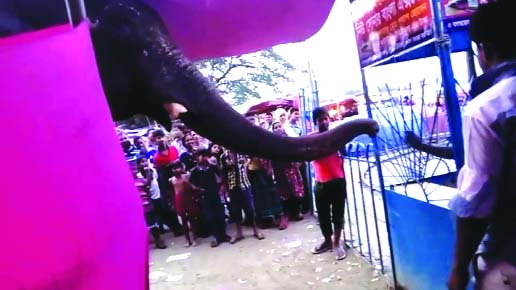
UNB, Dhaka :
Elephants, sometimes adorned with jewels and gaudy, decorative garments, are not an uncommon sight on the streets in many parts of Asia.
They can be seen ridden by their mahouts (riders or keepers) in public places where they artfully commandeer cash from passersby or unsuspecting tourists sipping a brew outside a cafe.
Bangladesh’s capital city of Dhaka is one such place where these magnificent beasts and their seemingly keen nose for cash, operate on the bustling streets.
In recent years, however, these elephants, or more specifically the way they have been trained, have become a growing menace in the capital city of some 16 million people.
This is because they are not just being used to collect money and entertain
people with their playful antics, as was the case in the past.
In Dhaka, mahouts mostly use the land’s largest animal for collecting money from the owners of shops and vehicles. The practice has come to be known as a form of “extortion” and such elephants have been dubbed as the “extortionists.”
The mahouts here use a simple method to force people to pay money to the tusked beasts with their probing, tactile trunks.
They simply make the elephant stop in front of a shop or a vehicle. Unless the shop owner or the vehicle owner parts with some money, the elephant refuses to move. Surprisingly, it also refuses to accept some banknotes unless they are of the requisite denomination.
Mahouts can be found riding their elephants in the middle of busy roads to collect money.
Hasan is one such mahouts who collect money from the streets of Dhaka with his elephant “Motilal.”
He learned the technique from his father who was also a mahout. “My elder brother is also an elephant handler. This trade runs in the family,” Hasan said.
Elephants, sometimes adorned with jewels and gaudy, decorative garments, are not an uncommon sight on the streets in many parts of Asia.
They can be seen ridden by their mahouts (riders or keepers) in public places where they artfully commandeer cash from passersby or unsuspecting tourists sipping a brew outside a cafe.
Bangladesh’s capital city of Dhaka is one such place where these magnificent beasts and their seemingly keen nose for cash, operate on the bustling streets.
In recent years, however, these elephants, or more specifically the way they have been trained, have become a growing menace in the capital city of some 16 million people.
This is because they are not just being used to collect money and entertain
people with their playful antics, as was the case in the past.
In Dhaka, mahouts mostly use the land’s largest animal for collecting money from the owners of shops and vehicles. The practice has come to be known as a form of “extortion” and such elephants have been dubbed as the “extortionists.”
The mahouts here use a simple method to force people to pay money to the tusked beasts with their probing, tactile trunks.
They simply make the elephant stop in front of a shop or a vehicle. Unless the shop owner or the vehicle owner parts with some money, the elephant refuses to move. Surprisingly, it also refuses to accept some banknotes unless they are of the requisite denomination.
Mahouts can be found riding their elephants in the middle of busy roads to collect money.
Hasan is one such mahouts who collect money from the streets of Dhaka with his elephant “Motilal.”
He learned the technique from his father who was also a mahout. “My elder brother is also an elephant handler. This trade runs in the family,” Hasan said.

